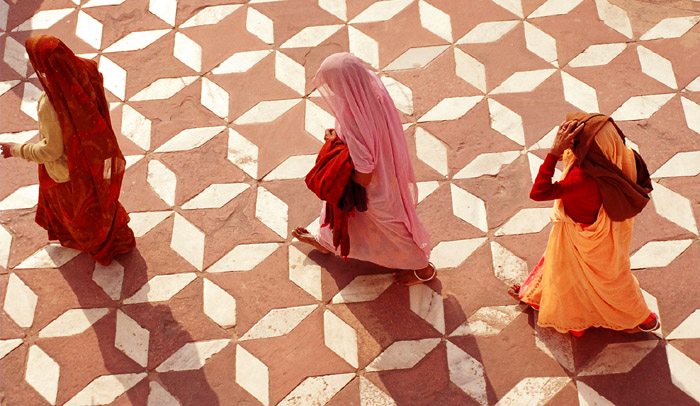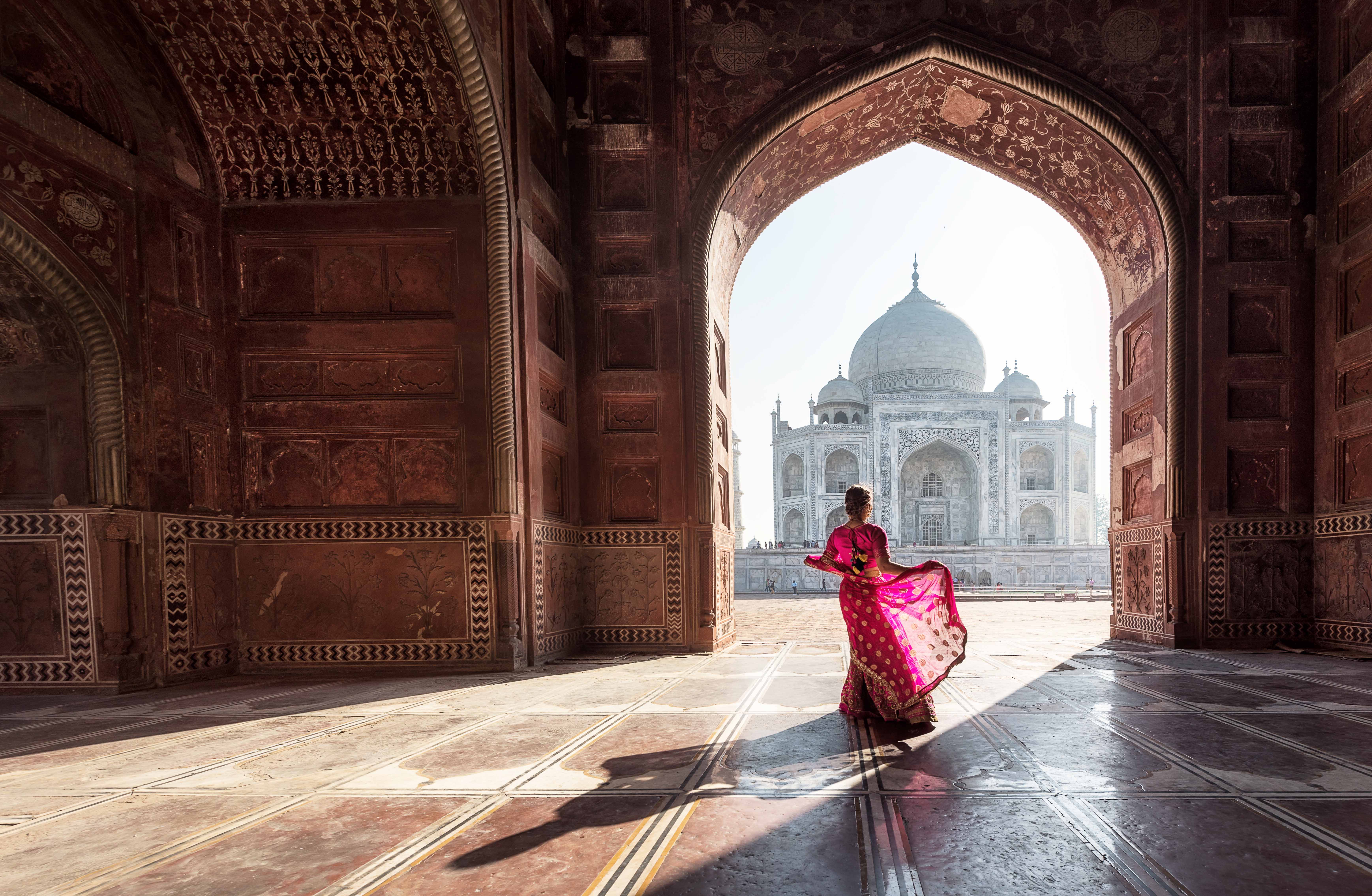There’s a reason that the Golden Triangle, which connects India’s much-visited cities of Delhi, Agra and Jaipur, is a classic route. In as little as a week, you can see some of North India’s most spectacular sights via good rail and road links, including the magnificent Taj Mahal.
QUICK LINKS:
Best way to travel the Golden Triangle
Fastest way to travel the Golden Triangle
Cheapest way to travel the Golden Triangle
Travelling the Golden Triangle by train
How to book a train ticket (and what class to book)
How to hire a car + driver
Find a hotel in Agra
Find a hotel in Jaipur
Find a hotel in Delhi
Delhi, the Indian capital, has fabulous sights, such as the Red Fort, Hanuman’s Temple and the Qutb Minar. From here it’s easy to travel the approximately 200km southeast to Agra, home of the ethereally beautiful Taj Mahal and magnificent Agra Fort.
The third corner of the triangle is Jaipur (238km to the west), Rajasthan’s ‘Pink City’, where you can shop the glittering craft bazaars, see Hawa Mahal (the ‘Palace of Winds’), and head out of the city to explore the incredible Amber Fort.
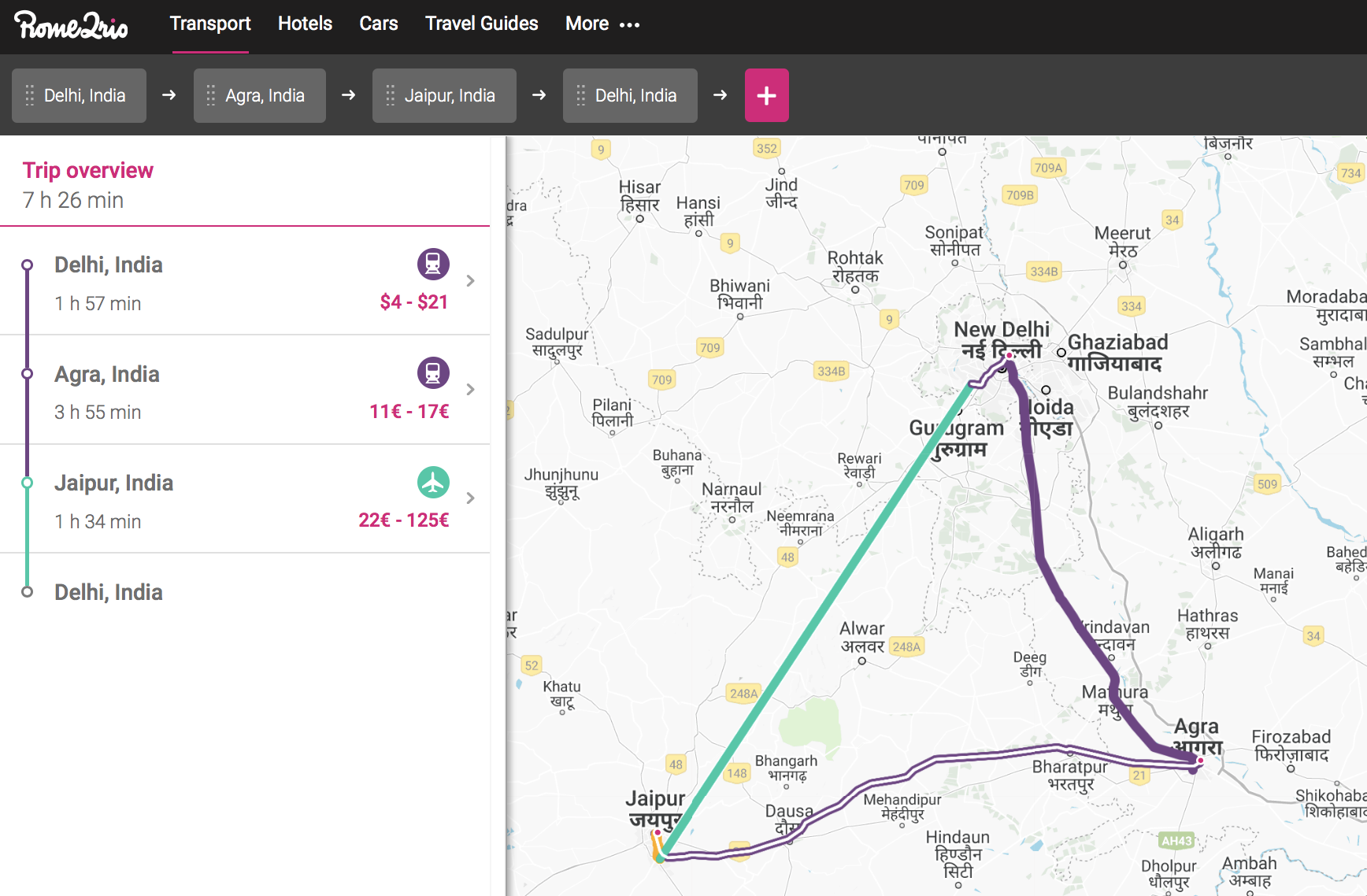
TIP: The best time to explore the Golden Triangle are the balmiest months of October to March, thus avoiding the monsoon and the heat of the summer.
Related articles:
- 7 ultimate tips to survive a long-distance bus journey
- Rome2Rio’s guide to ride-sharing platform BlaBlaCar: Is it right for you?
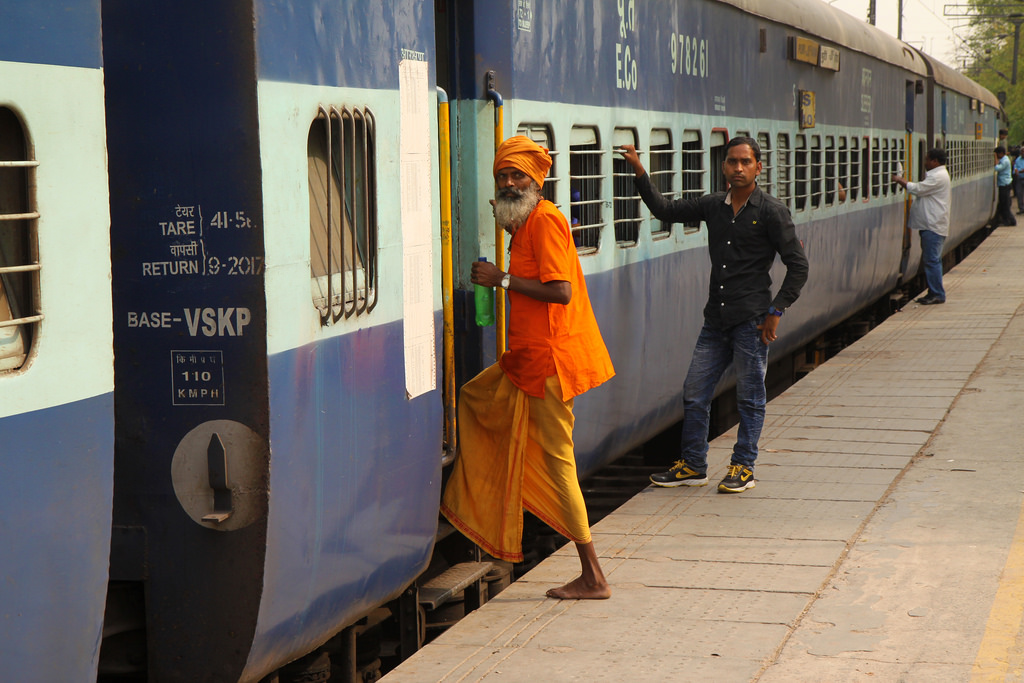
What are my options for travelling the Golden Triangle?
You can choose between trains, buses, taxis, planes and ridesharing on this route.
Trains range from slower multi-stop to faster and more comfortable services.
Buses also vary in degree of comfort, from rattling vehicles with hard seats and open windows to more luxurious air-conditioned tourist coaches with bunks, with prices varying accordingly (though never expensive).
Flying between Delhi and Jaipur can make sense, depending on your time constraints, but it’s much easier to get to/from Agra by train (even though the city does have an airport).
TIP: Rush hour on the trains and roads in India’s cities is pretty much all day, from around 8am to 8pm. Start early to avoid delays. For example, there’s usually a train from Delhi to Agra that leaves around 6am, arriving in Agra at 8am.
What’s the fastest way to travel between the cities?
Between Delhi and Agra: Train (2 ½ hr)
Between Agra and Jaipur: Car (3 ½ hr)
Between Jaipur and Delhi: Fly (1 hr)
What’s the cheapest way?
Bus is always the cheapest way to travel in India, with a range of bus types and operators. Bone-rattling, multi-stop buses offer the cheapest tickets, but it’s worth paying extra to ride in an air-conditioned tourist coach, often called ‘Deluxe’. These are run by regional companies, such as Rajasthan Roadways (RSRTC), whose buses depart from/arrive at Bikaner House in Delhi for Rajasthani destinations such as Jaipur. For Agra, there are many private companies, but the main bus companies leave from the Sarai Kale Khan station in South Delhi. You can buy bus tickets online via Redbus or Make My Trip, or in person at bus stations and local agents.
Rideshare apps, such as BlaBlaCar, are another affordable way to travel, but security can be a concern and it is not always easy to match up with people travelling the same direction.
Which mode of transport should I pick?
If you’re looking for an easy journey, or perhaps are cash rich but time poor, hire a driver and car for the entire trip, possibly flying the final section between Jaipur and Delhi if you’re desperate to reduce hours on the road. A long-distance taxi also means you can easily take detours or make stops on the way.
If you have more time but less money to play with, and want to spend time mixing with locals, take your pick between the train, bus and rideshare options. Out of the three, train is a fantastic (and usually efficient) way to travel in India, and is definitely the all-round winner for comfort and price on all sections of the journey.
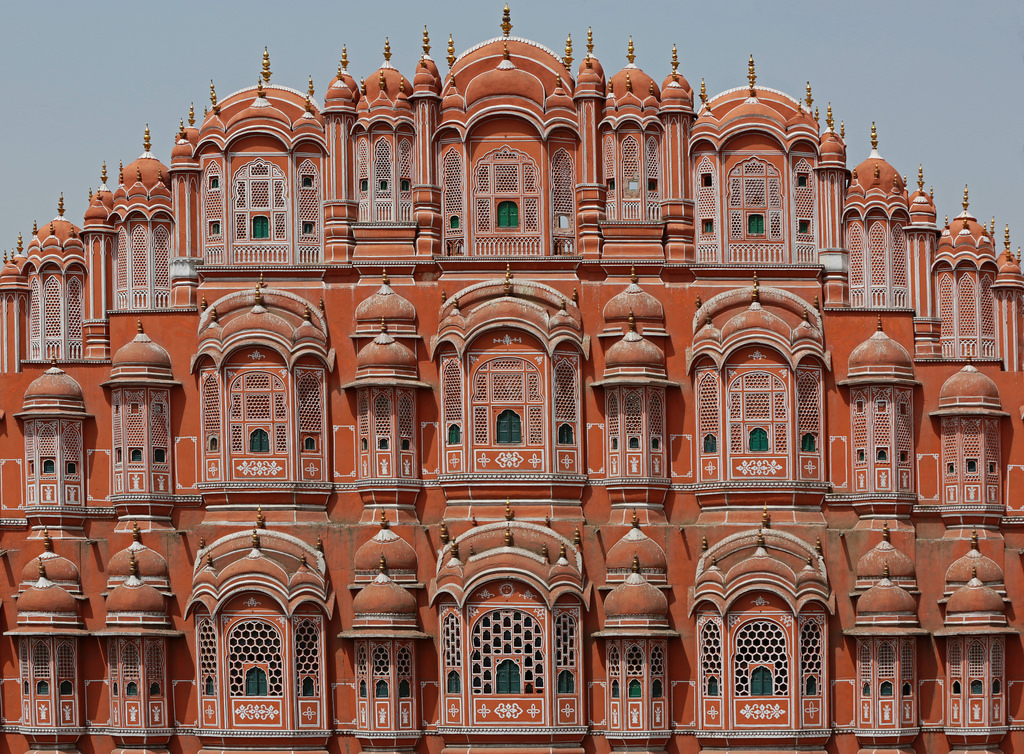
Can I fly between cities?
Flying between Jaipur and Delhi can be a good option if you’re constrained for time; flight time is about an hour (although getting to/from the airport, especially in Delhi, can add to this substantially).
Agra has an airport, but we don’t recommend it; getting to/from Agra and the Taj Mahal by train is the easiest and fastest option.
How does the train work?
Indian Railways, India’s national rail operator, runs a variety of trains on the Golden Triangle route that vary in comfort and speed. Choose a train according to your needs: timing is usually the most important factor, and you may want to plump for a more comfortable train as even the top-ranking ones are relatively inexpensive.
Top-of-the-range are usually the Rajdhani (for long distances) and Shatabdi (shorter distance) trains; the slowest are usually the Mail/Express trains, but they’re still fairly comfortable. All trains run direct on the Golden Triangle route.
TIP: The fastest and best timings-wise train from Delhi to Agra is the non-stop Gatimaan Express, India’s fastest train, which takes only 1 hour 40 minutes to reach Agra, and leaves in the early morning from Hazrat Nizamuddin station in Delhi. It runs daily except Friday, when the Taj Mahal is closed.
What train class should I book?
There is a bewildering variety of train classes, with different types of train having different levels on offer.
Usually 2A (two-tier bunks, air-conditioned) or CC (chair, air-conditioned) are where comfort and value meet, but the advantage of the cheaper SL (sleeper, no air-con) and 2S (chair/bench seats, no air-con) is that the windows open, making for a more atmospheric journey – although these carriages are not as clean or well-equipped, and tend to be busy.
Some trains have a female-only passenger car, but this tends to be crowded. If you’re looking for maximum privacy, go first class.
Main train classes
1A: AC first class: comfortable bunks, include bedding
2A: AC two-tier: two levels of bunks, include bedding
3A: AC three-tier: three levels of bunks, include bedding
EC: Executive chair car: AC seating coach with large padded seats
CC: AC chair car: Comfortable padded seating
SL: Sleeper class: 3-tier berths but with no AC (but the windows open)
2S: Second seater: similar to CC, but without AC (again, windows open)
UR: Unreserved general class seating: cheapest option, no AC, windows open; busy
From Delhi: New Delhi station and Hazrat Nizamuddin (more convenient for travellers staying in South Delhi) Book online via the Indian Railways site, or in person at stations or local travel agents. If you want to book on the Indian Railways site, you’ll need to register first. International mobile numbers are accepted (you’ll need to use a correct phone and email as you have to verify both). If your foreign postcode is not accepted, enter a random six-digit number. There is a small fee for anyone with a foreign phone number, which you pay when first logging in. Visa and Mastercard are both accepted. TIP: Once you have an account, you can download the IRTCT app (Android only) which is much easier to use than the website. It’s best to book your tickets in advance as these are popular routes; you can usually rock up and buy a ticket for an unreserved section (UR) on the day – but don’t count on getting a place to sit. On some trains, there’s a female-only passenger car, but this tends to be crowded. Advance ticket bookings usually open 120 days before the date of the journey for Indian nationals; 365 days for international travellers. If doing the booking yourself (rather than through an agent), you’ll need to book all three legs separately, and you’ll need to book a specific train rather than just turning up for any train that day. You’ll be allocated a seat when you book (there’s a small seat reservation fee, usually around 15-50 rupees), unless you’re buying a ticket for UR, the lowest, unreserved class. If there are no seats available you may be given a waitlisted ticket, which means you may gain a place in whichever class you’re booking – but there’s no guarantee, so be sure to have a back-up plan. Self-drive is an option, although traffic and driving conditions in India can take some getting used to. Most people prefer to travel by taxi: consider hiring a car and driver for a week, which will also make it easy for you to take side trips such as to the ancient Mughal city of Fatehpur Sikri, a 30-minute drive from Agra (it’s an hour by train), or to the pilgrimage town of Pushkar, which is 2.5 hours from Jaipur by road. Alternatively, you could make the first part of the trip from Delhi to Agra by train, then take a car for the next one or two sections of the journey, as you prefer. Avoid travelling by road after dark. India’s roads don’t have a great safety record and this is exacerbated at night. Research carefully to find a taxi for long-distance trips. Many travellers arrange this when they first arrive in Delhi and meet seemingly helpful touts – and end up paying over the odds for a substandard service. A reliable company in Delhi is Ola Cabs, or arrange through your hotel. The best way to go is via recommendations from fellow travellers to ensure you get a reputable company. TIP: Make sure you agree on a flat fare (which is usually worked out as a daily rate) and have everything clearly written down before you set off on your trip. If you are happy with your driver’s service, you should also tip a couple of hundred rupees a day. A recent revolution in transport is the emergence of carpool apps such as BlaBlaCar. This is a cheap way to travel, especially on a popular route like this, but relies on you matching up with others making the journey. There is a Ladies Only version of the app, which is a safer option for women travellers. Download the Rome2Rio app and plan your journey on the go.Where do the trains leave from?
From Agra: Agra Cantt
From Jaipur: Jaipur Junction
How do I buy a train ticket?
Can I drive the Golden Triangle?
How do I hire a car and driver?
How about ridesharing?
